Coming to her forever-home, she finally is. Just met her–while masked, of course–Thursday morning during the “At-Risk Hour” at the English Gardens in Royal Oak.
One of her kind–an Eastern flowering dogwood (Cornus florida)–was supposed to have been planted on our 40th wedding anniversary (May 12, 2019). That was after I developed pre-planting Arbor Day 2019 jitters. And those came about even after having thoroughly researched my way through a list of 14 possible tree choices suggested by friends. And. believing I’d hit upon the winner: an American Basswood (aka “The Bee-Tree”). What could be more perfect in these challenging times for our pollinators?

But botanist Bronwen Gates, who had been in my yard before, made a late contribution to my search, pointing out that there was already a canopy stretching over this spot on Earth.

Bronwen suggested I consider:
“what the space was calling for . . .”
Like, perhaps, a native-to-Michigan understory tree. And, then she suggested three possibilities.
More research led to a new decision: the Eastern flowering dogwood (Cornus florida).
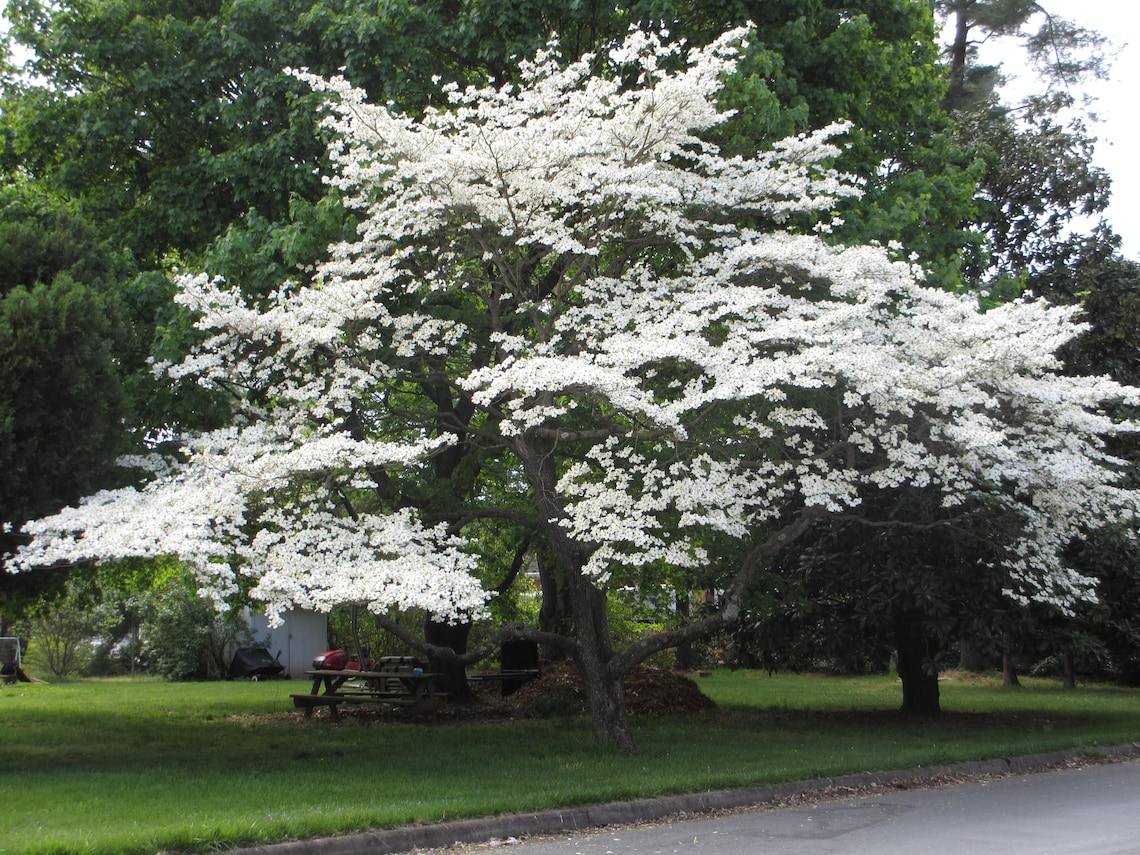
However, by the time that decision was made, the nursery of the landscaper I’d been working with (to help with a grading issue) no longer had any pink Eastern flowering dogwoods left in stock. And I had been thinking pink.
But, no worries, the season was warming up fast anyway, and he would have one for me on the next Arbor Day: April 24, 2020.
COVID Complications
Of course, then COVID-19 planted itself in our midst. Michigan’s Stay-at-Home order was loosened to allow landscapers to work on Arbor Day, of all days, so it wasn’t going to be an Arbor Day planting this year either. But, with excitement, I called the landscaper to confirm we were all set. In response to my inquiry, he responded that he’d not be able to get to me “’til mid-July.” At which point, of course, it would be too late plant a tree.
Obviously, if I wanted to plant a flowering dogwood this spring, I was going to have to expose myself (along with my at-risk husband and both of my parents in their 90s) to some risk.
An “under-water” introduction
Thursday, Kevin D–who had, coincidentally, helped us pick out our last Christmas tree–ushered us through the delivery entrance of Royal Oak’s English Gardens into the outdoor area of the store and directed us to the ornamental trees. A good thing the dogwoods happen to be located in the first two rows of the collection because this time of morning–between 8:00 and 9:00–the overhead rotating sprinklers were forcefully watering this half of the outdoor department. My husband, along for this relatively safe outdoor outing, wandered off to check out the shade perennials, which had already been watered.

I tiptoed through puddles, dodging the rotating streams of water, as Kevin braved direct hits to move in close enough to read the labels on the trees.
I should mention that over the winter my preference had turned from pink to white. He could only find two white dogwoods, both of the variety “Cherokee Princess”.
He said I might be able to find other white varieties at another English Gardens’ location. Aargh! I wasn’t prepared for a variety decision. (Only after I got home did I discover the reason I had no service–and so could not look up “Cherokee Princess” on my phone–was because somehow my “cellular data” setting had turned itself off. Just a weird coincidence or confirmation of a “meant-to-be”?)
Regardless, the At-Risk Hour was coming to a close. Given the Michigan’s COVID-19 lockdown under Governor Gretchen Whitmer’s Executive Order 2020-21 and my scary experience last Friday at Telly’s in Troy (the lack of any mention of COVID-19 on their website should have been my first clue) . . . was I really going to visit another English Garden location? Probably not.
Both trees looked healthy. I paid for the one of the two little dogwoods I thought looked strongest in terms of how it branched and made arrangements for Singing Tree to pick it up Tuesday.
Buyer’s remorse?
But would the other one with the branch splitting off low on the trunk grow up to be a more classically-shaped dogwood tree? And, had I picked the right variety of white dogwood?
This is the species of dogwood I purchased:
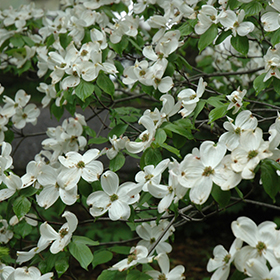
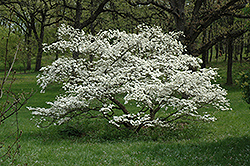
[Note: These and all photos of dogwood trees available from English Gardens below are credited in their plant database: “Photo courtesy of NetPS Plant Finder“.]
The Lichfield Dogwood
What I really had imagined was a dogwood tree with: 1) creamy white “flowers” (i.e., bracts) . . . and 2) the classic “dogwoody”, bonsai-like layering of branches (aka “a low-branching, broadly-pyramidal but somewhat flat-topped habit”).
To my mind, these qualities represent the “old-fashioned” variety of dogwood, like the mature dogwood that grew on Lichfield Rd. in Detroit, the block on which we owned our first house.
Although looking at it now, close up, the bracts look green, right?
Options I didn’t know about
A search of English Gardens’ database, which contains a total of 25 (!) different dogwood varieties, yielded two other varieties of white Cornus florida:
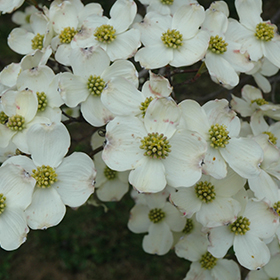
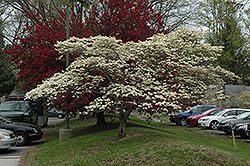
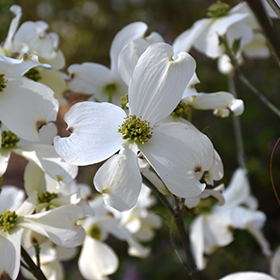
Above: Bracts of “Appalachian Spring Flowering Dogwood” ;
Below: Specimen of “Appalachian Spring Flowering Dogwood” (Cornus florida ‘Appalachian Spring’)
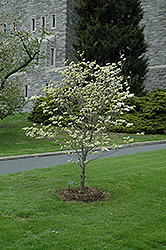
. . . And two hybrids (notice these varieties lack the “florida” in their name, the species part of the tree’s name. Cornus is the genus part of the name).
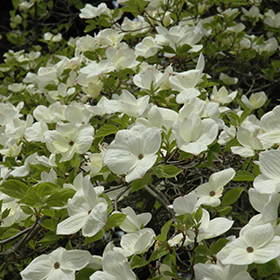
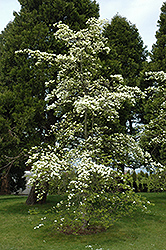
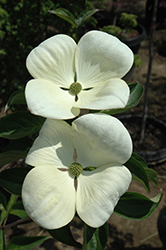
— Venus Flowering Dogwood Flowers
(Cornus ‘Venus’)
Two additional white dogwood hybrids were available by special order only. The calendar and the forecast high temperature of 89 for Tuesday–the tree’s scheduled planting day–were certainly not going to allow time for any special ordering!
Now what?
Research, of course.
After looking closely at all of the other photos I could find online and doing a little reading, I discovered that all of these white flowering dogwood species are good for bees, butterflies, and birds. All flower in the spring, produce bright red berries, and add color to the landscape in autumn.
My notes and decisions along the way include:
Cherokee Princess
- 15 to 30 feet high and a 15 to 30-foot spread
- “‘Cherokee Princess’ is a cultivar that is noted for its consistently early and heavy bloom of flowers with large white bracts. Originally introduced in 1959-60 as C. florida ‘Sno-White’.”
- I like the bracts; they may even turn out to be creamier white than some of the other varieties.
- Good rust-red fall color.
- “May be inadvisable at this time to plant this tree in areas where dogwood anthracnose infestations are present.”
Wait, what? Dogwood anthracnose infestation? Is that a problem in my zip code???
Cloud 9
- Maybe this look is closer to what I was imagining?
- 15 to 30 feet high and a 15 to 30-foot spread
- “May be inadvisable at this time to plant this tree in areas where dogwood anthracnose infestations are present.” Oh-no!
Appalachian Spring
- I don’t care for the space between and slight curl of the bracts.
- 15 to 20 feet high and a 15 to 20-foot spread
- However: Has 100% resistance to anthracnose . . . Of course, it does.
Eddie’s White Wonder
- A cross between the Cornus nuttallii, the native Western dogwood and the Cornus florida, the Eastern North American species
- A “particularly attractive hybrid variety with profuse white blossoms, a distinctive growth pattern [I wonder what is?] and enhanced disease resistance.”
- Named after its creator: British Columbia nurseryman Henry Matheson Eddie (1881-1953) in 1945.
Venus Flowering Dogwood
- A 1973 cross between the Cornus nuttallii var. “Goldspot”, the native Western/Pacific dogwood, and Cornus kousa var. Chinensis, which then was pollinated with pollen from C. kousa “Rosea,” a pink-flowered Japanese dogwood in 1983. The resulting variety was patented as Venus in 2003.
- Cornus kousa is not a native tree . . . so, this one is out.
The bottomline, my brain, and privilege
I want a native flowering dogwood with white flowers, preferably creamy and with the classic layering branches.
Given the dogwood anthracnose threat, maybe ‘Eddie’s White Wonder’ would have been my best choice. (They did have some of that variety left over from last year–albeit frost-damaged–at Telly’s.)
More to the point:
- What exactly has the lockdown done to my brain with respect to my decision-making aptitude?
- Or with respect to the length at which I will write about . . . or anticipate how long readers might care to read about, well . . . indecision. (Even if one is a tree nerd.)
And, yes, I do realize how very fortunate I am to be so privileged–especially at this time in our world’s history–to be healthy and have the leisure to worry about what variety of native white flowering dogwood tree I will choose to have planted in my yard.
I could call around to English Gardens this weekend. I could visit any one of the other 5 locations of English Gardens between 8:00 and 9:00 Tuesday morning.
Or I could stop obsessing and que sera sera. . .
Tuesday approaches. Stay tuned.


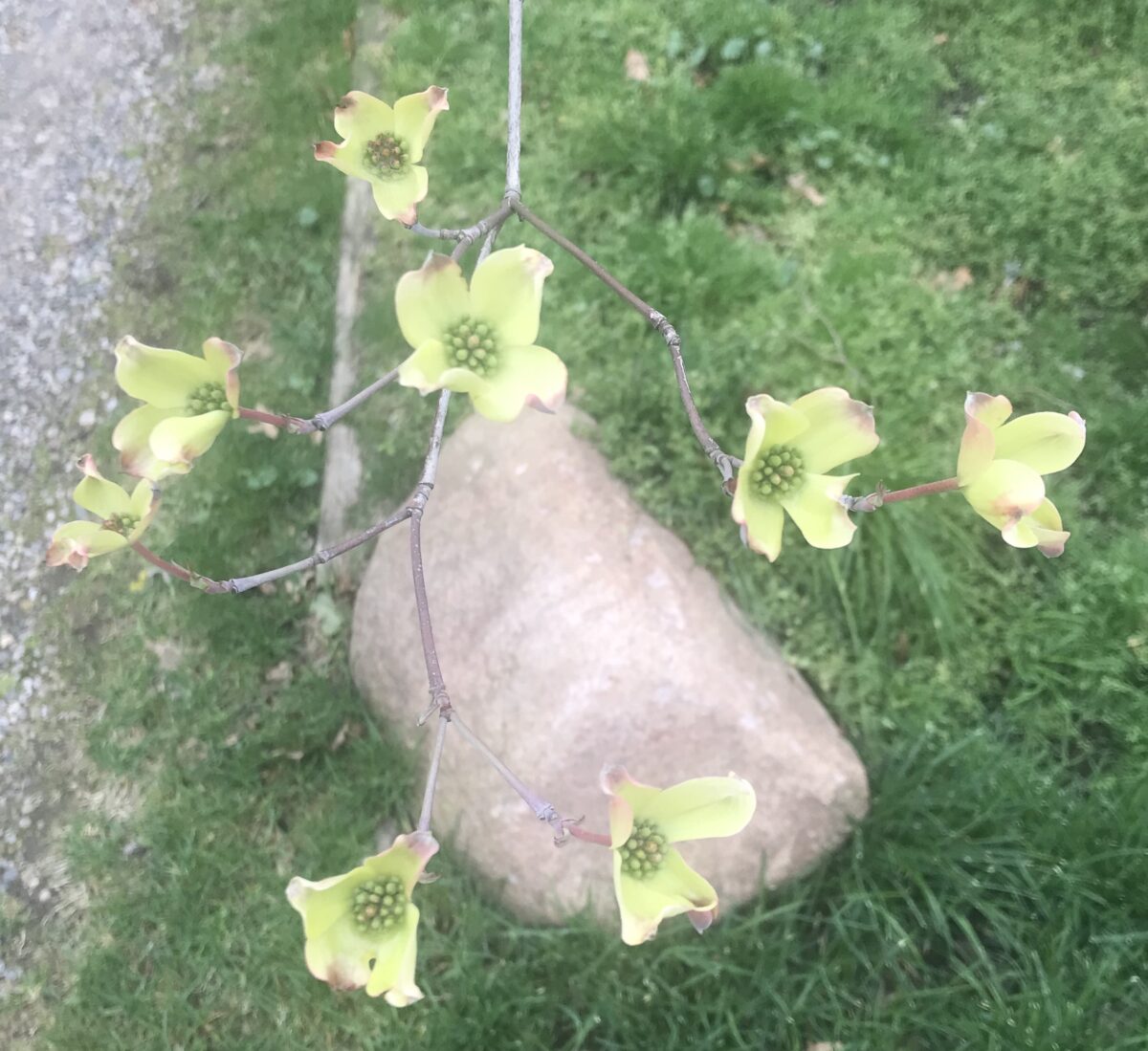



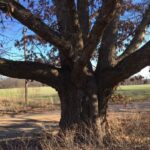
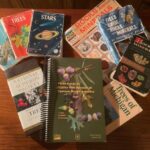
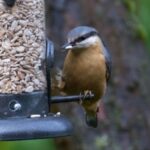
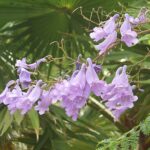

I think the Princess is the prettiest, and will surely fight off anthrac nose, which sounds like a particularly bad respiratory infection — is there a Cipro for trees? It’s good to see you blogging again!
It turns out, Susan, that the Princess Emily is in more sun than I thought she’d be, but the fact that she-who-loves-shade is not in much of it may help prevent her from an anthracnose infestation.
Thanks, Susan. I hope you’re right about her being the prettiest and a fighter! Propiconazole is a systemic foliar fungicide that helps treat dogwood anthracnose, which I know too much about already, but I promise not to blog about it!
The Princess looks classic and lovely. I am glad you decided against pink (I am prejudiced and believe white is the ONLY color for Dogwoods. And my neighbor has one that had been pink for years – but now is white!)
You will never be sorry about planting a dogwood. Mine was a tiny tree from Frank’s Nursery, planted over 25 years ago. It is my joy. I look at it every day – sit under it all summer long. We are putting an addition on our house this year (maybe, if the COVID ever lets us) and I told the architect he had to stop at the dogwood. I will not sacrifice my tree for a bigger bedroom.
I was walking through the Oak View Cemetery in Royal Oak to day and noted several beautiful Dogwood specimens blooming there.
Thanks, Beth! I’m glad I decided against pink, too. Not sure what I was thinking. Ah, remember Frank’s Nursery?! Yes, I was in the Oak View earlier this week and noticed them too. Beautiful they are!
So glad you’re blogging again, MD. The Princess it is!
Yep, who would know? Apparently, the search that began last February was all leading up to princesses. Craig and I, craving a story we could embark on together, were recommended “The Crown”. I realized last night, watching Episode 6 on our 6th consecutive night, that we’ve been involved with a fair number of princesses this week!
I hope the tree has a better time than poor Margaret!
Me, too!
I love dogwoods, MD. So, you did get the Cherokee Princess?
Cherokee Princess is the variety of dogwood I thought I wanted, but then came the “dueling princesses,” and I went for Princess Emily, Martha. One of the postings I posted this week describes all of the native white variety of Eastern flowering dogwoods. Besides the two I’ve already mentioned here, one might consider: Eddie’s White Wonder, Cloud 6, or Appalachian Spring.